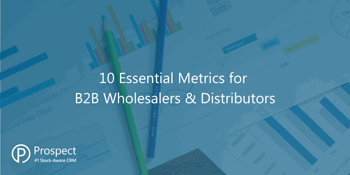
10 Essential Metrics for B2B Wholesalers & Distributors
 For B2B Wholesalers and Distributors, understanding your customers’ buying patterns is essential for business growth and success. But it’s easy to feel bombarded with acronyms and phrases, so we’ve put together a need-to-know, top 10 list of metrics for product businesses.
For B2B Wholesalers and Distributors, understanding your customers’ buying patterns is essential for business growth and success. But it’s easy to feel bombarded with acronyms and phrases, so we’ve put together a need-to-know, top 10 list of metrics for product businesses.
1. Average Order Value (AOV)
What is it?
Tracks the approximate monetary value of each order placed by customers during a set period of time.
Why’s it Important?
Once calculated, it indicates where your investment should be directed (e.g., on advertising, sales, etc.,).
How’s it Calculated?
AOV = Total Revenue/Total # of Orders (expressed as a monetary value i.e. £, $)
It’s pretty easy to calculate this one manually, but it depends on how many customers you have and the number of orders coming in. The higher volume of orders and the larger the customer base, the harder it is to work out. To make It more meaningful and accurate, it should be evaluated pretty frequently - preferably daily - so that it takes into account things like buying trends or seasonal activity.
2. Average Order Frequency (AOF)
What is it?
Shows how regularly customers have purchased from you over a set period of time.
Why’s it Important?
It can be an important indicator that you’re losing customers to competitors if your AOF dips. For example, if someone usually places an order twice a week, then they suddenly don’t place an order for three months, something’s wrong.
How’s it Calculated?
AOF = Total # of Orders/Total # of Customers (usually expressed as a number of days or months)
Again, not rocket science to calculate this one, but tracking order frequency across your entire customer base and analysing for trends Is pretty tricky to do Independently and regularly.
3. Recency, Frequency & Monetary Value (RFM)
What is it?
Simply put, RFM is a well-known, well-loved Marketing and Account Management strategy for segmenting customers using the data you have on their spend pattern. It segments customers by 3 dimensions - Recency, Frequency, and Monetary Value, then handily slots customers into the RFM segments, which include "Champions", "Loyal Customers", "At Risk" and "Hibernating".
Why’s it Important?
Everyone wants a repeatable and predictable way to grow their business, but to do that, you need to be a mind reader and know what each customer wants from you. That’s what RFM is.
High scores identify the most promising customers, enabling your team to build experiences that keep them engaged, but lower scores are useful too. They help you identify new customers that need to be onboarded and nurtured, previously loyal customers that have found a replacement product and should be reactivated, and customers who buy low-value items regularly that are prime for an upsell campaign.
So RFM is pretty cool. In fact, we think it’s the best-kept secret for growing Wholesale, Distributor & Manufacturing businesses!
How’s it Calculated?
Calculating RFM may seem complex and daunting - that’s because it is. Take a look at this blog to learn more on how to calculate it manually, but in truth, we strongly recommend you automate it (it’s a really, really hard calculation!).
4. Churn Rate
What is it?
The rate at which customers stop buying from you.
Why’s it Important?
High churn can stifle business growth. Your churn rate is a good indicator of customer loyalty and staying power. Yes, putting more customers in the top is Important, but your leaky bucket will never fill with a high churn rate!
Note: you actually need to know your churn rate to be able to calculate 5: CLTV!
How’s it Calculated?
Churn Rate = Lost, Cancelled or Inactive Customers *100/Active Customers (expressed as a %)
Fairly simple to calculate, but just It’s essential that you monitor churn rate regularly and can interpret the results. For example, if your churn rate is high, why? Is it courier issues, late deliveries, competitor activity?
5. Customer Lifetime Value (CLTV)
What is it?
This one predicts the total revenue expected to be generated by a customer throughout their lifetime buying from you. CLTV compares a customer’s revenue to the predicted customer lifetime.
Why’s it Important?
There are loads of reasons why this one is important - for a start, it helps you work out how long you need to keep a customer before you start making a profit! It also helps you compare the cost of retaining customer vs. acquiring a customer, which can help inform marketing decisions (it’s widely referenced that acquiring a new customer can cost up to 5x more than retaining an existing one!).
How’s it Calculated?
CLTV = Average Order Value x Average # of Orders in a Year * Average Retention Time (expressed as years or months)
Not a horrendous calculation by any means but made all the more easier when automatically worked out as your business grows.
Note: you need to know this one too ready for 9: LTV/CAC!
6. New Customers Signed/ Month
What is it?
A summary of the new customers acquired in one month. This one can be measured by both gross customers and net of churn customers.
Gross customers signed each month is simply the total number of new customers added, whereas net of churn customers measures the difference between the rate that you’re losing customers and the rate that new customers are being added.
Why’s it Important?
This metric indicates if customers are being retained or lost, so it’s absolutely vital for B2B product businesses.
How’s it Calculated?
Net of Churn Customers = Net Revenue Lost from Existing Customers/Total Revenue at Beginning of Time Period
7. Customer Acquisition Cost (CAC)
What is it?
The costs associated with acquiring a new customer (i.e. the Sales and Marketing spend required to attract and convert them).
Why’s it Important?
CAC helps you see if you’re spending more on trying to attract new customers than the value of the customers you’ve acquired. So, keeping these customers for longer (i.e. your CLTV) is then even more important.
How’s it Calculated?
CAC = Total Costs Acquiring New Customers/# of Customers Acquired (expressed as a monetary value i.e. £, $)
Note: you need to have this to hand for 8: CAC Payback, and 9: LTV/CAC.
8.CAC Payback
What is it?
The number of months it takes to breakeven the money that was invested in Sales and Marketing by acquiring revenue from new customers. In other words, the time it takes to get payback on your CAC.
Why’s it Important?
A shorter payback time is better - it indicates that you’re more profitable.
How’s it Calculated?
CAC Payback = Total costs invested in new customer/# of Customers Acquired (usually displayed as months, days or years)
9. Lifetime Value/ Customer Acquisition Cost Ration (LTV/CAC)
What is it?
A ratio that compares the costs of acquiring a new customer with the predicted monetary gain from their lifetime purchasing from you.
Why’s it Important?
It’s your ultimate new-customer acquisition profitability and determines if you’re spending too much or too little in acquiring new customers.
How’s it Calculated?
LTV/CAC = Customer Lifetime Value/Customer Acquisition Cost (displayed as a ratio e.g. 3:1)
10. Transactional vs. Relational Customers
What is it?
Calculates the percentage of new customers that become repeat customers (and what percentage aren’t), based on the idea that that those who have ordered with you more than 4 times are likely to become relational customers.
Why’s it important?
As a business selling hundreds, potentially thousands, of products B2B, it’s critical you know what percentage of your customers turn into repeat business.
Once a customer has placed 4-5 orders, it becomes much more likely that they will place another order again soon, then settle into a weekly/bi-weekly purchasing pattern. We’ve done some analysis on this - check out our findings in this blog.
So, if you can identify that you’re not getting those all-important first four orders, you can find ways to secure them (e.g. marketing campaigns).
To sum up - for service or subscription-based businesses, the repeat subscription is super regular. Customers pay their monthly subscription every month, almost without fail. But for businesses who take repeat orders, it’s not so perfectly regular, meaning calculating all these metrics gets harder.
Looking for a CRM system that instantly and automatically calculates these metrics for you? See for yourself! Take a no obligation Free Trial or book a demo with one of our experts today.
